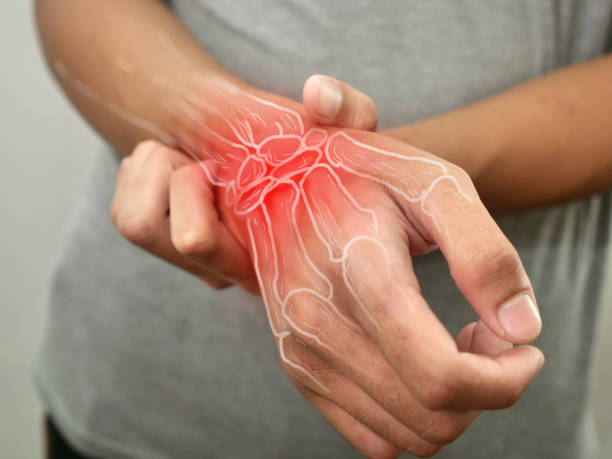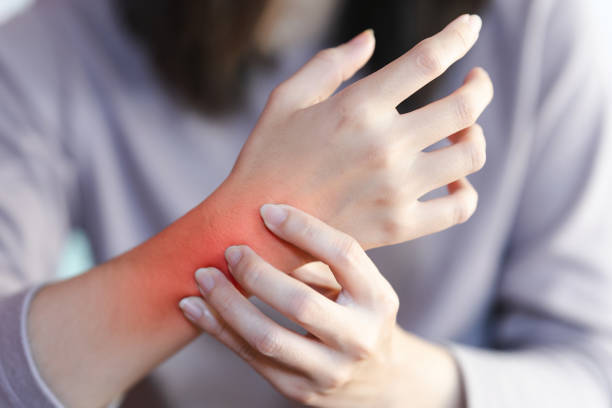The healing time for wrist sprains can vary depending on the severity of the injury and proper management. Mild sprains typically heal in 2 weeks while more severe injuries may take up to 6 months to fully recover from.
Fortunately, there are several things you can do to speed up your recovery. Some of these include consuming hydrating foods and beverages like water and decaffeinated teas.

1. Rest
It is important to rest your wrist for the first couple of days. This will reduce inflammation and help heal the ligaments. Elevating your wrist and icing it can help control swelling. You may also want to try over-the-counter pain relievers to manage the injury.
Once you have a clear diagnosis and are cleared to begin movement, start with light resistance exercises that focus on the wrist. For example, use a can of water or a small dumbbell to perform wrist pronation and supination, flexion, and extension movements (sets and reps of 2-5 per movement).
Stay hydrated by drinking lots of fluids (water or herbal tea). This will promote blood flow, which helps heal muscles. A study found that dehydration can worsen muscle injury recovery.
2. Ice
The wrist consists of 15 bones and several ligaments — strong bands of tissue that connect the bones. Even if you’re careful, there’s a reasonable chance that during any given workout or activity, your wrist will be injured. This could be from repetitive activities or falling on an outstretched hand, or it could occur while you’re playing a sport.
When the wrist becomes sprained, the first thing to do is ice it to reduce pain and swelling. This may mean a medical ice pack or simply using a bag of frozen peas in a pinch. However, using too much ice can slow down the healing process, so use it sparingly. You can also take NSAIDs, such as ibuprofen (Advil, Motrin) or naproxen (Aleve, Naprosyn), to relieve pain and inflammation.

3. Compression
The wrist is held in place by a tough band of ligaments that connects fifteen separate bones. Falls, twists and sudden movements can damage these ligaments, which cause pain, swelling and bruising. The intensity of these symptoms depends on the severity of the sprain.
X-rays of the wrist can help determine the severity of the injury. An MRI or CT scan may also be ordered if more information about the wrist ligaments is needed. An arthrogram—in which dye is injected into the joint—can also be useful.
For mild sprains, you can use an elastic compression bandage to reduce swelling. Ice, as well as nonsteroidal anti-inflammatory drugs (NSAIDs), will also decrease pain and swelling. For moderate injuries, your doctor may recommend a wrist brace or splint.
4. Heat
The wrist is a complex joint made up of 15 bones that connect the forearm and hand. Any trauma that puts pressure on the ligaments in the wrist can cause a sprain.
While a sprained wrist may feel better after a few days, it’s crucial to avoid certain activities that can prolong the injury. Trying to return to normal activities too soon can lead to increased inflammation and turn a microscopic ligament tear into a more severe injury.
Using heat, like heating pads or a hot compress, too early can also make an acute injury worse. Early use of heat draws more blood to the injured area and increases swelling, which can lead to more pain and a longer recovery time. Only use heat later in the healing process.
5. NSAIDs
Most minor wrist sprains respond well to ice, over-the-counter pain medications like ibuprofen and a short course of nonsteroidal anti-inflammatory drugs (NSAIDs). Some people also use topical treatments such as gels or creams that you rub on.
NSAIDs work by stopping the production of chemicals called prostaglandins that amplify the electrical signals from nerves to the brain that cause pain. This helps to relieve pain, reduce fever and also help reduce the swelling.
NSAIDs come in pill form and can be taken at home or in hospital. Selective NSAIDs such as celecoxib (Celebrex) have less risk of causing peptic ulcers, gastrointestinal bleeding and other side effects in the stomach and intestines. They are particularly helpful in reducing joint and muscle pain. They are also often used in long-term arthritis treatment.
6. Stretching
Keeping the wrist limber and active can help prevent re-injury. While you don’t want to overdo it, a few passive extensions of the injured limb each day can make a big difference. This includes extending the injured limb to its full range of motion several times a day, but not placing painful pressure on it.
It is important to see a doctor to make sure that your injury isn’t more serious than you think. You could have a bone fracture or torn ligaments, both of which require the attention of a medical professional. While it’s tempting to skip a visit with an orthopedic specialist, this is usually not a good idea. A Pinch Of Prevention can help ensure that you recover quickly and avoid any unnecessary setbacks.
7. Strengthening
For moderate to severe sprains, a doctor explained to you how long does a sprained wrist take to heal and also may prescribe a wrist brace or splint to immobilize the injured area and prevent further damage. Your doctor can also recommend stretching and strengthening exercises to regain range of motion in the injured wrist.
Even if you’re an experienced athlete, you can still hurt your wrist. It’s easy to lose your footing, tumble safely and sprain your wrist.
Most wrist sprains get better with rest, NSAID pain relievers and the use of a splint or brace to limit movement. More serious sprains may require surgery to reattach the ligament, using either direct reattachment or a tendon graft. It can take up to a year for the injury to heal completely. Staying hydrated can help speed up the recovery process, as dehydration can worsen inflammation.
